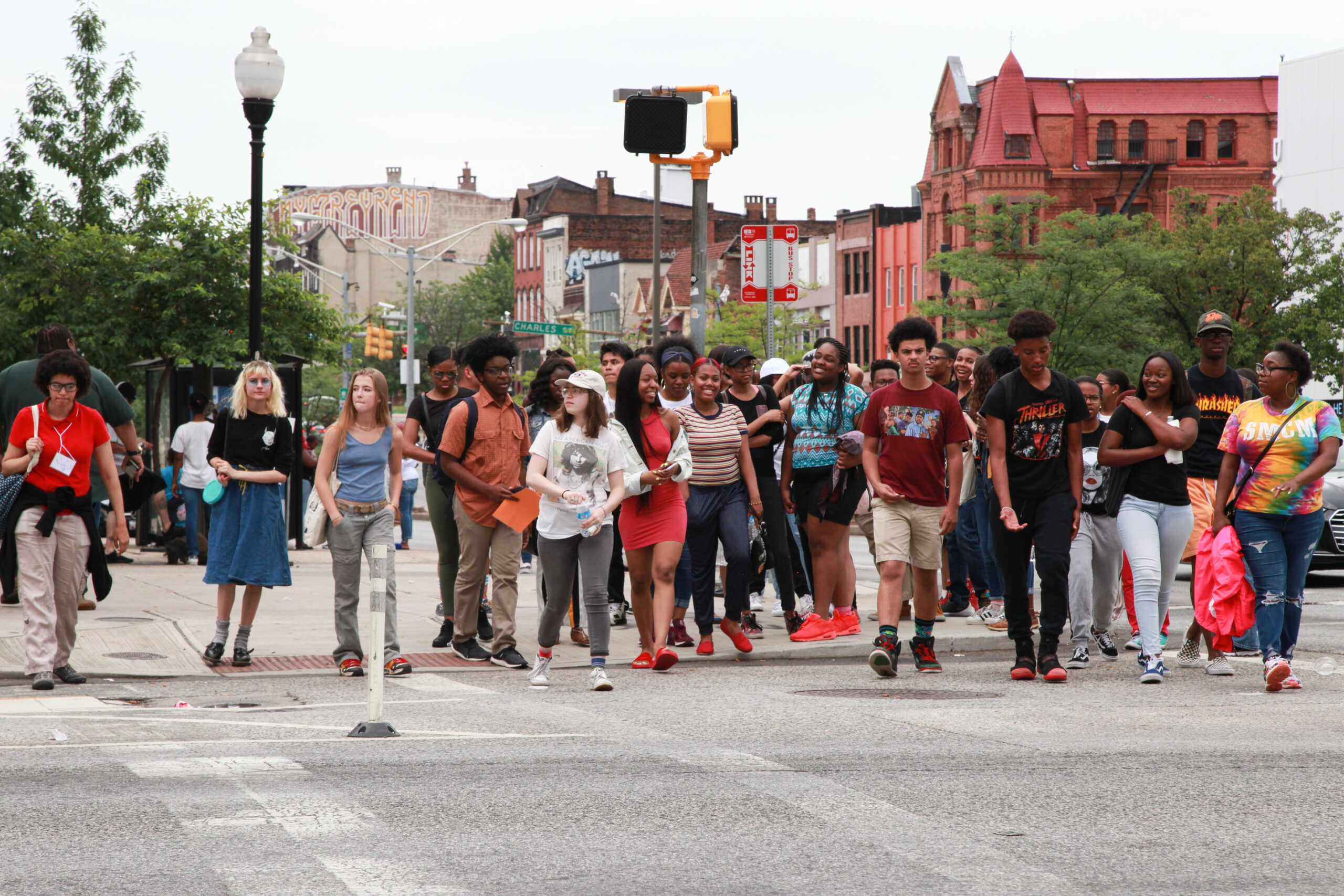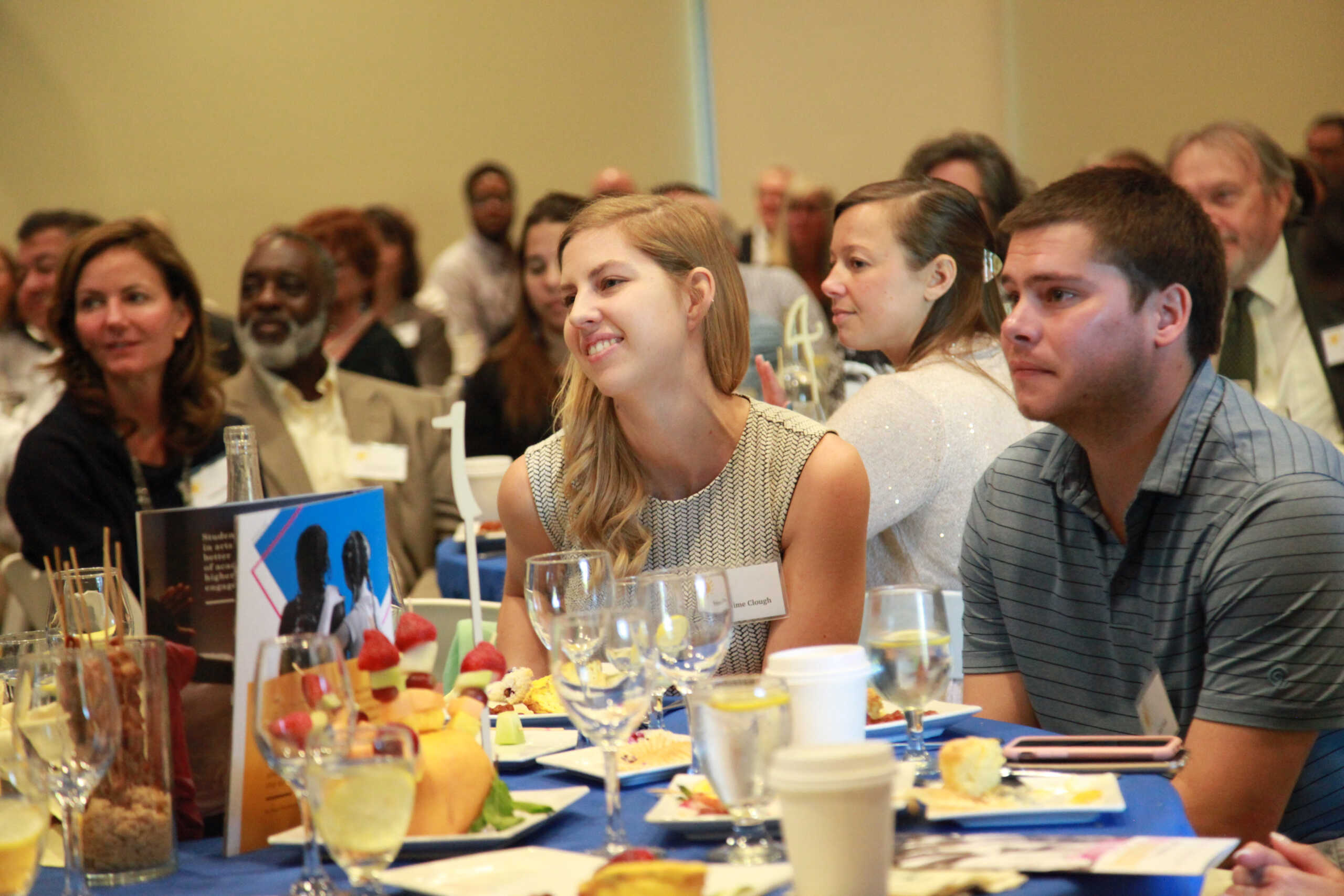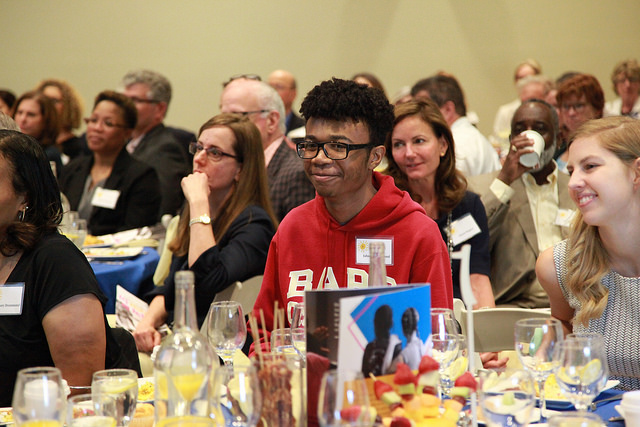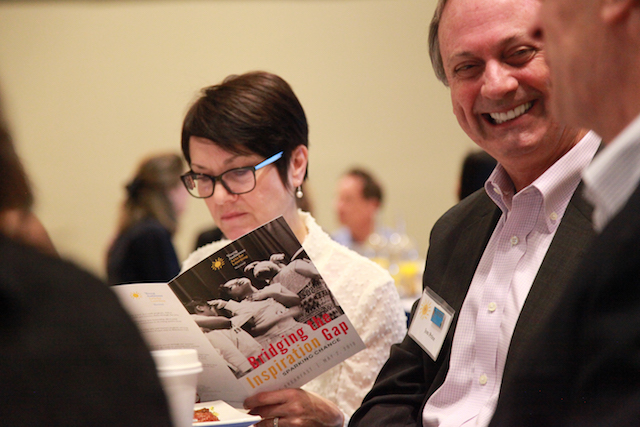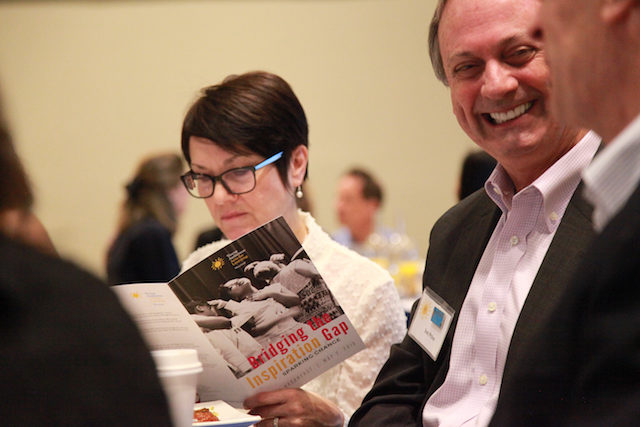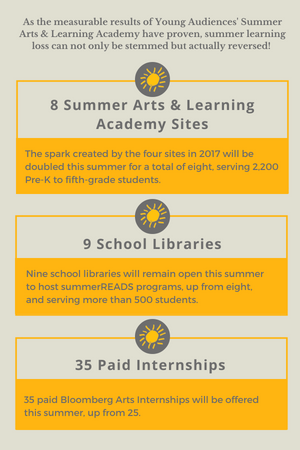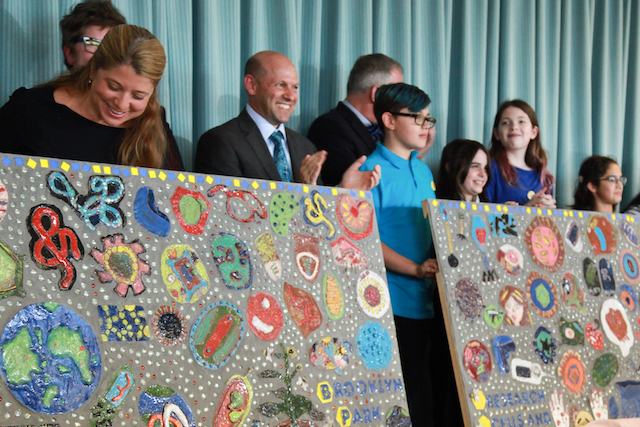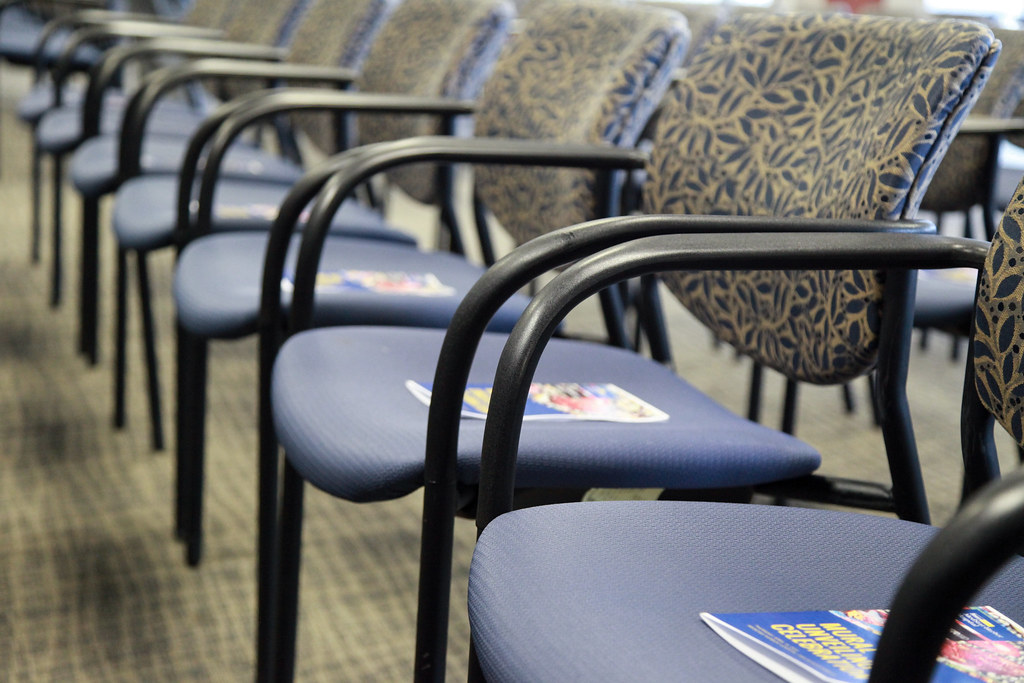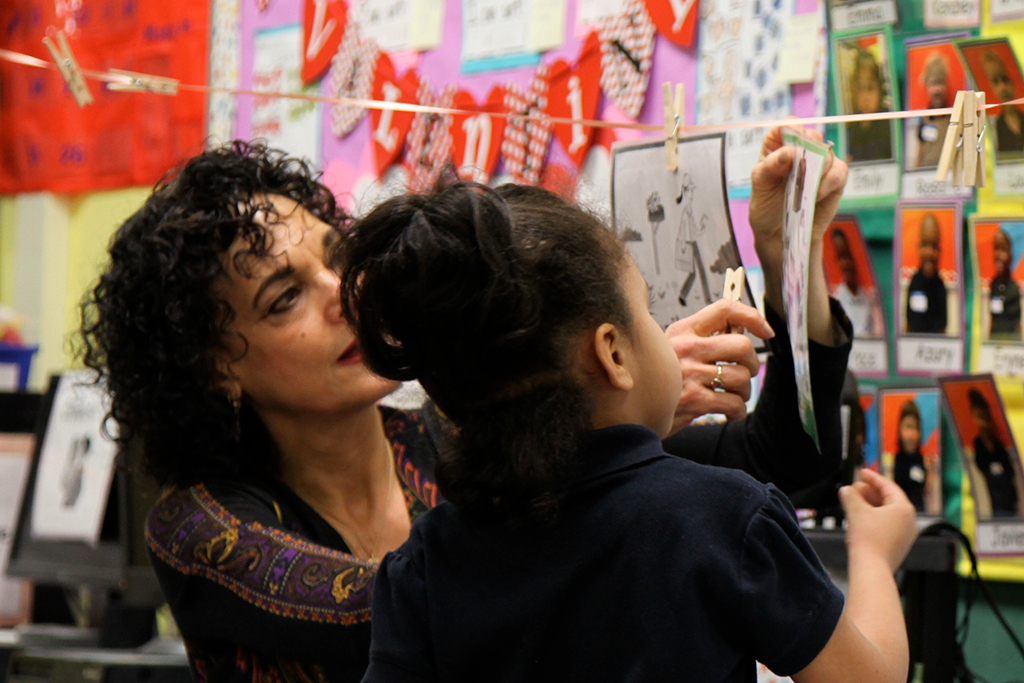Blog
Building a Network of Support in the Arts
The school year may only have just ended, but this year’s cohort of Bloomberg Arts Interns have already been hard at work for three weeks now. They attended a week of rigorous orientation and participated in behind-the-scenes tours and presentations at arts organizations. And perhaps most significantly, interns have gotten their feet through the doors of a number of reputable arts and culture organizations and have begun weaving themselves into passionate and supportive arts and education networks.
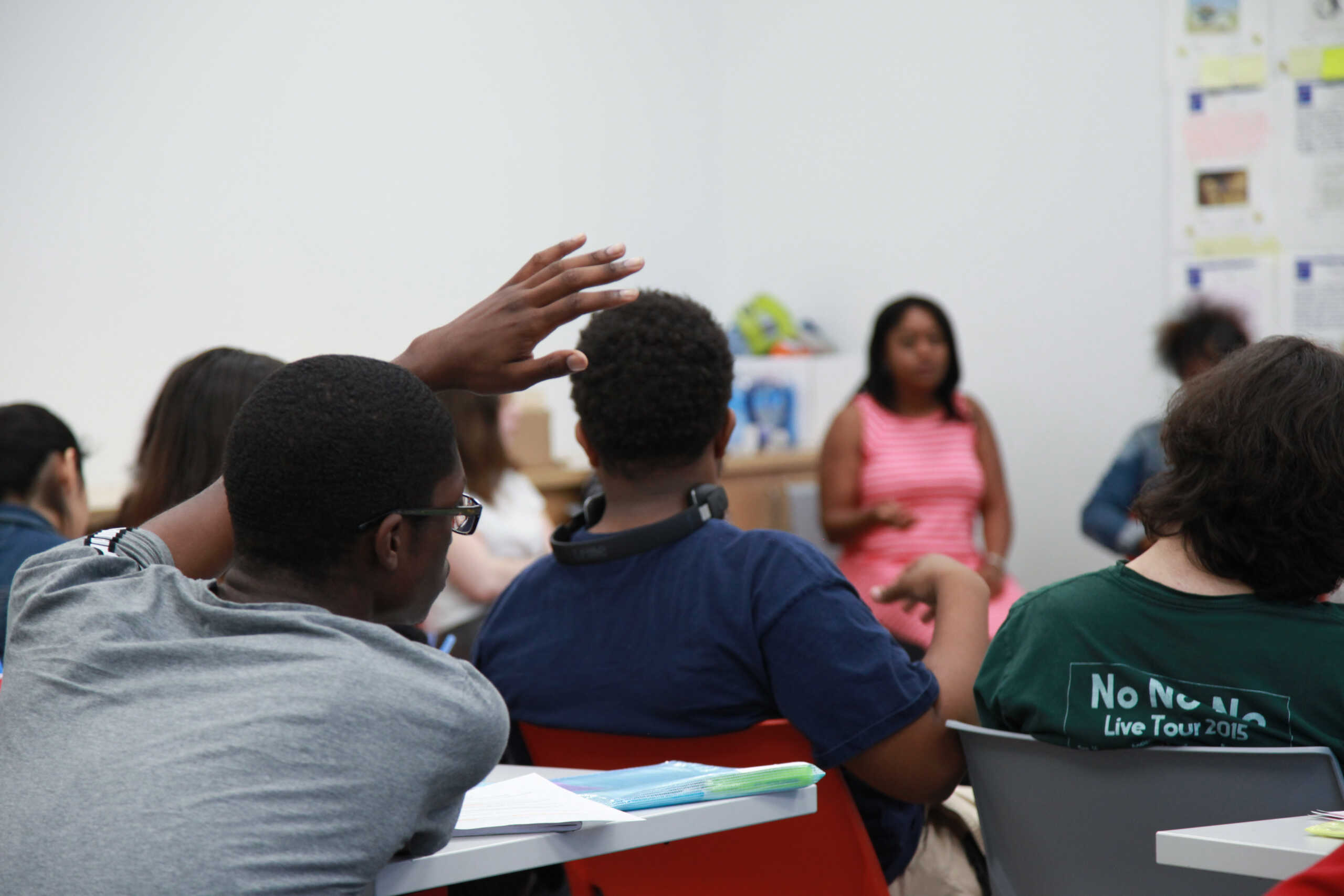
Outside of their internships, the students participate in professional development, college prep workshops, and writing coaching sessions. On these days, students receive guidance and support with completing college applications and build strong career skills with mentors and writing coaches. They create personal essays, write responses to art and performances, and work not just on college applications, but prepare for the bills, the challenges, and the change that comes along with transitioning to a college or university.
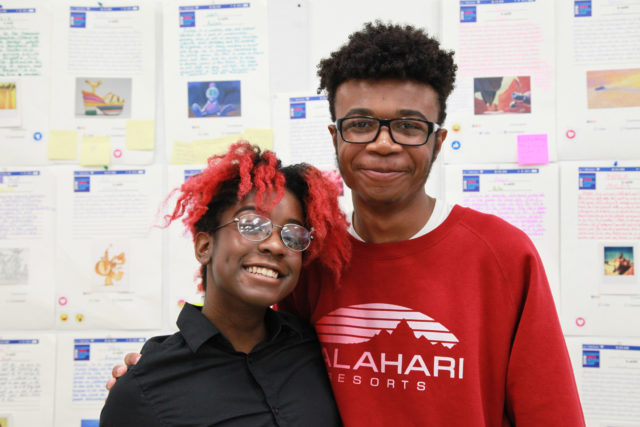
Two of last summer’s Bloomberg Arts Interns, Jahsol and Sequoia, will be headed to Bard College at Simon’s Rock and the Arts Institute of Chicago, respectively, in the fall. But first, the pair visited students at OpenWorks to answer questions and give them insight into their own internship experiences last summer. The questions poured in. While just a year older than the 2018 interns, Jahsol and Sequoia had so much knowledge, experience, and wisdom to impart, getting this year’s cohort excited about the possibilities to come.

A college panel brought together three community members to talk about first-hand challenges, solutions, and to provide conversation and guidance in applying and adjusting to college life: Danielle Staton, Program Manager of Fund for Educational Excellence; De’asia Ellis, a Frederick Douglass High School graduate and current Goucher College student; and Ruben Ramirez Jr., a graduate of Digital Harbor High School and restaurant entrepreneur.
From practical advice, like applying to more than one school and developing a plan for time management, to being prepared to handle rejection, facing culture shock and loneliness away from home, or confronting ignorance and discrimination, the panellists shared valuable online resources and their honest experiences to help prepare the interns for what may come in the next year, not to mention all the steps required just to apply. “It’s hard when families don’t know how to get there,” said Ms. Ellis. She advises students who may not have family to support them through the daunting application process to find a mentor to help guide them.

As the summer progresses, this year’s cohort will continue to be afforded the chance to explore art of every discipline, and to meet and learn from artists, curators, and everyone else who works so hard to keep local institutions dynamic, engaging, up, and running. And while they are busy working on projects for their worksites, they will be networking. They will be making lasting connections, opening themselves up to all that is possible in a career in the arts, and forging their futures.
The Bloomberg Arts Internship is managed by Young Audiences through the support of Bloomberg Philanthropies. Learn more about the program here.
Andrew Greene Shares the Art of Ragtime on smARTbeats!
smARTbeats returns to WTMD on Saturday, June 9 during the weekly children’s program Young At Heart!
On this month’s segment, host Lisa Mathews sits down for a chat with pianist, conductor, musicologist, and founder of the Peacherine Ragtime Society Orchestra, Andrew Greene. A new addition to the Young Audiences roster, Andrew is excited to share his love and appreciation of Ragtime in Maryland schools and open ears and imaginations to the genre!
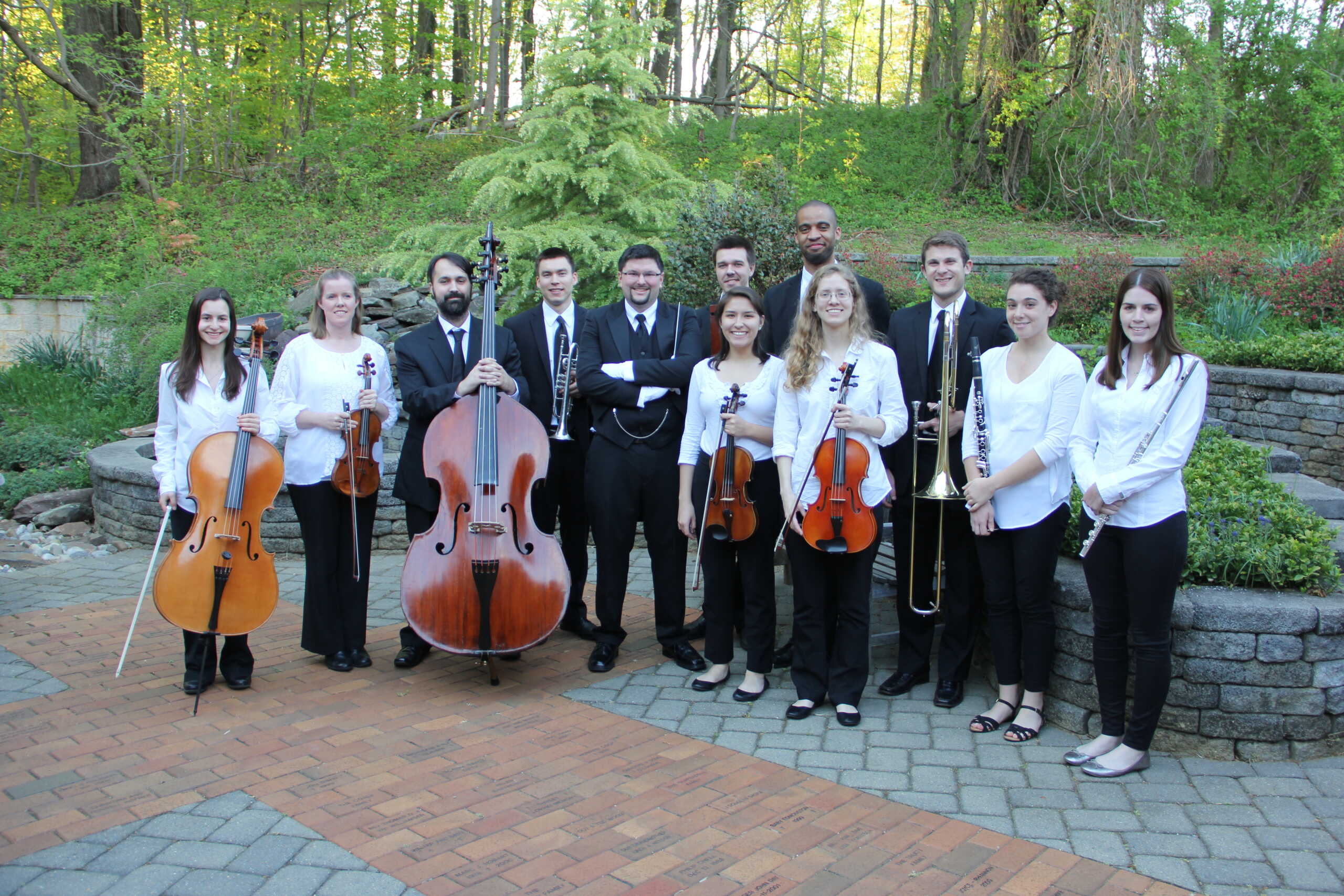
Be sure to tune in to hear the artist talk about bringing to life important, historic films by performing original silent film scores from the era! On his website, Andrew explains, “All of our silent film scores use the actual music that existed when the films were originally released – it’s the closest thing to actually being back in the silent era!” The group accompanies short silent films featuring renowned actors like Charlie Chaplin, Buster Keaton, Harold Lloyd, or Laurel and Hardy.
As an ensemble that re-creates the sounds and sights of a century ago, the Peacherine Ragtime Orchestra is both entertaining and educational. The musicians teach their audiences to understand, appreciate, and make connections to modern-day examples of the music they present, how sound can impact emotions, and to think critically to understand the role sound plays in creating scenes, moods, feelings, and emotions. “With critical thinking, we can create a scene just using music and sound!”
This unique ensemble gives audiences a true appreciation for the role ragtime music played in the art and history of cinema and an understanding of how ragtime music relates to the music we hear today. “When film was in its beginning stage 100 years ago, there was no sound to accompany the movie — so we work with audiences to show how sounds can change how we think about a certain scene or action sequence.” Their work has not gone unnoticed. “The premier American ragtime ensemble” as hailed by the Washington Post is rapidly becoming the leading professional ragtime orchestra in the United States- which is great news for Maryland students.
Young At Heart airs weekly on 89.7 WTMD from 7 to 8 am on Saturdays, featuring music that appeals to parents and children alike. Previous shows have featured music by Wilco, David Bowie, Andrew & Polly, Weezer, and others.
Listen online as YA teaching artist, conductor and musician Andrew Greene of Peacherine Ragtime Society Orchestra joins host Lisa Mathews in the studio!
Summer All Year
Written by Jaime Clough
The 2nd grade Baltimore City Public Schools teacher spoke about how the tools she learned at Summer Arts & Learning Academy have informed her teaching and transformed her classroom at Young Audiences’ annual Impact Breakfast earlier this month.
“Buffalo Woman, go,” Mr. Briggs nudged me. I stepped onto the stage, took a deep breath, and began my lines. I was eight and dressed in a leather Native American dress with beads and fringe. I was shy, but I had done the work. By the morning of the production, I had read primary texts, written a research paper, and created my own costume. So, when I stepped onto that stage, I was not timid or nervous, but passionate and proud. This was my first experience with arts integration.
Fourteen years after my role as the Buffalo Woman, I was accepted into Teach for America Baltimore and began teaching at Margaret Brent Elementary/Middle School in Charles Village. My students are diverse. One walked with her family from Mexico to America. One, who cannot yet read, learns in the same space as another, who is reading Harry Potter. Some of my students come to school without having eaten since the night before. Others rarely have clean uniforms.
I knew what I wanted to do in my classroom, but I didn’t have the tools to execute my ideas.
It was last March that I found Young Audiences. They matched me with fiber artist and Young Audiences teaching artist Katherine Dilworth, and together we went through a one-week professional development class. I learned how to use song and rap to teach students multiplication, and theatre to understand points of view in a story. During Summer Arts & Learning Academy, for the first time, I taught the way I had always wanted to teach.
As part of our literacy unit, students read City Green. To help kids understand the message of the book, “what makes a community?” and connect with the characters, Katherine and I planned a lesson around creating a community garden out of woven flowers. We’d use our art standards to create ABAB patterns and connect math standards for adding and subtracting the strings.
We had one student in the class with lots of sensory difficulties. He had challenges with personal space, with expressing his emotions, and would often just put his head on his desk. As he began to wind thread through his loom to make his flower, I was ready for him to say, “It’s too hard,” and stomp away. After 15 minutes of weaving blues and purples, a pattern emerged. His flower was taking shape beautifully. He was adding and subtracting, counting his strings, and weaving the pattern. Absorbed in his work, he sat without prompting for the longest amount of time since I had known him. “Ms. Clough, look! Ms. Clough, I did it,” he said. “I made my flower and it’s so cool!” That was the spark.
From that moment on, my student was different. He raised his hand. He worked with partners. He asked questions about how to make his work better. Without that moment at the beginning of summer, we would not have seen a change in him. The arts gave both him and me the tools we needed to help him succeed.

My classroom after SALA is a different world. Teaching through the arts doesn’t just work for some students, it works for everyone. I have the highest engagement I have ever had, we are on track to grow two years in one school year as a class, and there is a spark in every single eye in the room when I write the lyrics to a “Ms. Clough Original” on the board. iReady, ANET, and DIBELS tests do not make us anxious anymore. When we walk into the computer lab, my students cheer because now they know they can do it. They are confident because they know their math and reading strategies from the songs, skits, and choreography we use every day. The successes and swagger among students in my classroom are because of the skills I gained while teaching with Young Audiences. Now, my dream is to be a principal so that I don’t just have a classroom of sparks, but a whole school of them.

Jaime Clough is a 2nd Grade Teacher at Margaret Brent Elementary/Middle School and Summer Arts & Learning Academy Classroom Teacher. Her first-hand experience is a testament to the power of arts integration in the classroom and is an example of the incredible strides a class can take both emotionally and academically when children learn through the arts.
Future So Bright
Written by Jahsol Drummond
The 2017 Bloomberg Arts Intern and Filmmaker delivered the following speech at Young Audiences’ annual Impact Breakfast earlier this month.
My name is Jahsol Drummond. I am eighteen and currently a senior at Bard High School Early College. I have attended Baltimore City Public Schools since kindergarten and I have never been a big fan. I was always told I was a good kid but my grades never really reflected that. From early on I was put in a box. Once I got to middle school, classes were separated and labeled 31 through 34. We all knew that groups 31 and 32 were supposed to be for the smart kids and 33 and 34 were for the “dumb” ones. I was in 33, and the stigma of feeling lesser set in, but I was also just glad I wasn’t in 34.
When I didn’t get good grades in middle school, I couldn’t get into a good high school, and a cycle began. This is the problem. In middle school, a composite score based on the grades you earn determines where you can go to high school. Once kids get behind in their education here in the city, they get derailed and there isn’t much help to get you caught up. Luckily, I found Bard High School Early College, a school with college-level expectations that encourages its students to think. Bard gives kids who haven’t done well in the current system a second chance and (I think) a better education than any other city school can provide.
I first learned about the Bloomberg Arts Internship from Bard’s guidance counselor. This program, which is managed by Young Audiences, matches students with arts and cultural organizations for a paid internship over the summer. I wanted to be a filmmaker, but I wasn’t sure how to go about it.
So, I was excited when I was accepted into the program and Young Audiences matched me with Tim Nohe, who is the Director for the Center for Innovative Research in the Creative Arts (CIRCA) at UMBC and a filmmaker. We clicked instantly. We saw that we had a common interest in using film to communicate perspectives.
On the first day, Tim and I hit the ground running. He taught me how to use the camera, and how to use editing software. My first project was to film interviews with the arts staff at the university. I was involved throughout the entire production process: from researching the artist, to formulating the questions, filming the interviews, and editing the footage. Tim believed in me and over my six weeks at CIRCA, I was exposed to the world of professional filmmaking and working with people to create pieces of work that I cared about. I made something I was proud of and a spark ignited. That first-hand experience helped me get involved in the local industry and I came away feeling like I had earned the title of filmmaker.
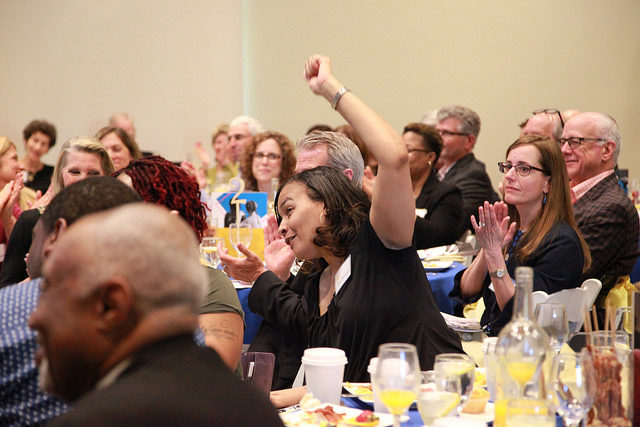
On top of connecting me with a great worksite, Young Audiences helped me and my fellow interns apply to college. We spent time working on our college essays and doing extensive research on the colleges we wanted to attend for the next fall. Today, I’m graduating from Bard with an Associates degree and I will be attending Bard College at Simon’s Rock in Massachusetts on a full-ride scholarship and with all of my current credits carried over.
At the end of the summer, Young Audiences required me and the 24 other Bloomberg Interns to present what we learned in a public presentation in front of hundreds of people. I had the opportunity to show what I had learned by producing my own video for my presentation. I was really pleased with how it turned out, and there were leaders in the city’s arts and cultural industry who were impressed with my work too.
My dream is to communicate the problems in our educational system through film, and now that I have finished the program, I know that I can do this. I hope my films inspire a spark within others to make a change. I now know enough to trust my spark to guide my work, and Young Audiences hiring me to film all three of YA’s summer programs this year means that others believe I have it in me, too. My career has only just begun, and it’s already so exciting. Thank you to Young Audiences and Bloomberg for opening this world up to me, and a special thanks to Tim for showing me the way.

It Only Takes a Spark…
Written by Barbara Krebs,
Young Audiences volunteer and Sunburst Society member
Spark. Ahh, now that’s a great word. Quick, simple, to the point. And it’s versatile – noun or verb – it’s all good. And if you’re a fan of onomatopoeia (and who isn’t?), well, I think spark works well there, too.
If you attended the 11th annual Young Audiences Impact Breakfast, you heard that word a lot. First, from Stacie Sanders Evans, President and CEO of Young Audiences, whose drama teacher sparked a passion that would put her on the path to her leadership of YA. You heard it from Jaime Clough, a second-grade Baltimore City Public School teacher who taught in YA’s Summer Arts & Learning Academy (SALA) and who has used the tools and strategies learned at SALA to transform her classroom during the school year. You even heard it from a student. High school senior Jahsol Drummond spoke about his experience developing his video and editing skills at the Center for Innovative Research in the Creative Arts (CIRCA) at UMBC in last summer’s Bloomberg Arts Internship. He shared his plans for the future as a college student (he was awarded a full scholarship to Bard College) and as a filmmaker. “My career has only just begun, and it’s already so exciting,” Jahsol beamed.

It is amazing where a spark will take you if you have the passion and determination to stoke the fire.
But, of course, the thing about the Impact Breakfast is not just the inspirational stories we hear from the presenters, nor is it solely about acknowledging the remarkable strides Young Audiences has made over the past few years in overcoming summer learning loss. These are important and wonderful things to witness, no doubt. But what truly struck me this time around was the synergy of people attending this event united by the desire to improve educational opportunities for the children in our communities.
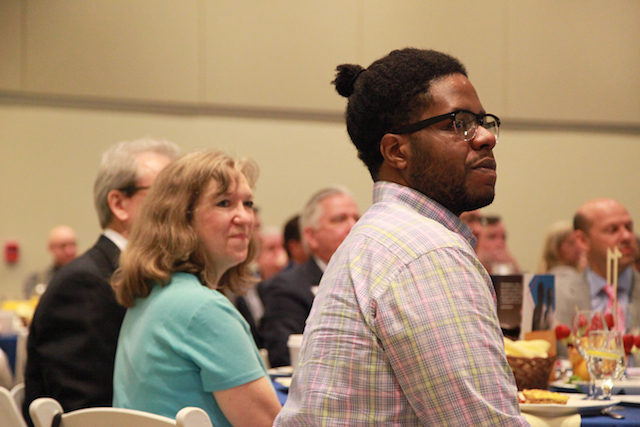
Seated to my right was Kariz Marcel, a DJ, music producer, teaching artist, and founder of the nonprofit Innovation Echo Alliance who is seeking ways to partner with Young Audiences and other educational organizations through his music industry connections. As he explained it to me, he was hoping to establish a roster of professional recording artists who would be willing to donate a small portion of their music royalties to these organizations as an ongoing and sustainable way to raise funds for education in our local schools.
Another gentleman at our table was Lieutenant Steven Thomas, a member of the Anne Arundel County Police Crisis Intervention Team. He and his team identify youth who can be helped by, for instance, after-school programs, like the Police, Artist, and Community Engagement program (PACE), and then find ways to make these things happen. For example, when it was discovered that transportation was an issue, they partnered with the school system to provide it. That meant getting the school-approved CDL bus license so they could drive students on the county’s buses. A little spark of creativity to problem solve what might otherwise have been a deal killer. Instead, police officers are keeping local youth involved in enrichment programs.
Likewise, I got a chance to talk briefly with Dr. Stuart Levine, President and Chief Medical Officer of MedStar Harbor Hospital, who I had heard speak only a week before at the unveiling of the mural that now sits in the lobby of the hospital’s Emergency Department. This mural, which focused on how cells and viruses interact with human and animal bodies, was created by sixth-grade biology students from Brooklyn Park Middle School. The project was the result of a multi-week Young Audiences teaching artist residency in partnership with Arts Empowered Minds Initiative (AEMI). So here was yet another way that a group, which is pivotal to the lives and health of its local community, had found a way to connect with young students, perhaps sparking future collaborations?
And that is just a small sampling of the conversations I had at my table alone. As I looked across the room, I could only imagine what discussions, ideas, creative solutions, and inspirational tales were being shared elsewhere. Knowing that so many people had gathered because they have a passion to improve the educational lives of our youth, I came away from the event feeling recharged, hopeful and, yes, ready to find fresh ways to kindle the spark – in whatever myriad forms it appears – in my own life and those of others.
Indeed, there is no telling what particular spark at what precise table will catch fire and generate a lasting, positive impact.
But that’s the Impact Breakfast for you – a kaleidoscope of people who are sparking change and impacting the future for our children!
Steve Cyphers Talks the Physics of Sound on smARTbeats!
smARTbeats returns to WTMD this Saturday, May 5 during the weekly children’s program Young At Heart! On this month’s segment, host Lisa Mathews sits down for a chat with professional frontman and percussionist, Young Audiences teaching artist Steve Cyphers. Tune in and you’ll hear why Maryland students absolutely love drumming with Mr. Steve!
The musician has performed for audiences on stage his entire adult life, touring with bands in the U.S. and abroad, contributing drums, percussion, songwriting, and vocals. “I truly believe music and art can help break down social and political walls and help to build cultural bridges,” Steve explained. “That being said, I simply enjoy performing for, and with, people!”
In schools, Steve helps students gain a deeper understanding of playing and notating rhythms and the science of sound. In addition to body percussion and call-and-response exercises, Steve’s students learn how to play a bucket with mallets designed and fabricated by the artist to accentuate the high and low pitches of the buckets, and to provide more volume control for the classroom. With Mr. Steve in the classroom, students investigate the physics of sound waves and even get creative by altering their “instrument,” to change its sound.
“I’d like to inspire students to venture further into music and performance, and interact with them in a positive, fun, and educational way.”
And inspire students, he does. If you’ve ever wondered what true happiness looks like, just watch a group of Steve’s students singing and playing James Brown’s “I Feel Good” on bucket drums!
Young At Heart airs weekly from 7 to 8 am on Saturdays, featuring music that appeals to parents and children alike. Previous shows have featured music by Wilco, David Bowie, Andrew & Polly, Weezer, and others.
Hear Steve Cyphers‘ smARTbeats interview online now!
STEM Cells? Nah, STEAM Sells!
Written by Barbara Krebs,
Young Audiences volunteer and Sunburst Society member
Excited. Proud. Love. These are the three words that I heard repeatedly as I attended the unveiling of the mural that sixth-grade students from Brooklyn Park Middle School created. Though these are not words typically linked with a middle school science project, they help illustrate the magic that is produced when you combine science education with an arts-integrated approach to learning.
The collaboration between their science class and a professional teaching artist from Young Audiences, in partnership with Arts Empowered Minds Initiative (AEMI), resulted in a 10-foot science-themed mural, titled “Brooklyn Park Middle Students Research Cells and Viruses.” As explained in the program, the mural “illustrates the dynamic, multifaceted interactions occurring thousands of times a day between cells, viruses, and living things.”
I wasn’t sure what to expect as I entered MedStar Harbor Hospital‘s Baum Auditorium in South Baltimore, but I immediately felt welcomed as a saxophone quartet from Brooklyn Park Middle played classical music. Their melodies formed a soothing backdrop to the animated conversations between medical personnel, artists, educators, politicians, parents, students, and others who had gathered for the event. A delightful spread of food – chicken satay, veggie trays, fruit and cheese platters, and even cupcakes for the kids – provided by the catering arm of the hospital, Morrison Healthcare, ensured that no one would walk away without all their senses satisfied.
But I digress. As the reception wound to a close, the formal program began. First up, Stacie Sanders Evans, the President and CEO of Young Audiences. Reaching for a hospital analogy, she spoke of Young Audiences’ facilitating role behind the scenes as the “spinal cord” or “backbone” that makes the arts-integrated learning possible in area schools. She described how Young Audiences partners with schools and other organizations like AEMI and the Arts Council of Anne Arundel County (who helped fund this project) to pair core curriculum teachers with professional teaching artists to enhance learning experiences in Maryland classrooms. Rather than rote learning, students explore academic subjects in any number of hands-on, arts-oriented ways.

Next was Dr. Stuart Levine, President and Chief Medical Officer of MedStar Harbor Hospital. He told the young student artists just how meaningful their creation would be to the hospital, saying that it would be proudly displayed in MedStar’s Emergency Department lobby. He talked about the VIPs in the room – the sixth graders – who had created this mural. He told them, “When community members come in for care, when they’re sick, when they are at their moment of need, they’re going to come into a place that has this incredibly hopeful work on the wall that’s made with love by the kids of their community.”
Then Dr. George Arlotto, Superintendent of Anne Arundel County Public Schools, spoke, stressing, “People who don’t even know you love you; people who don’t know you are proud of you.” This was the legacy that, even as young tweens, they were creating for their community.
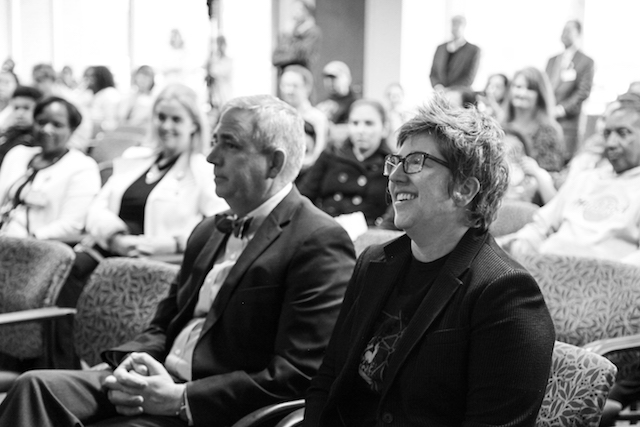
Following Dr. Arlotto, the two teachers who guided the kids through the process spoke. Lisa Radike, the Brooklyn Park Middle school science teacher, recalled that this process helped the kids learn more than just the science of cells, it also helped them “learn how to get along, how to work together.” Amanda Pellerin is the Young Audiences artist who taught them to mold clay, shape it into the cells and viruses they were studying, and then assemble an entire mural from all the different parts they had imagined and created. As she looked proudly onto the students, she made sure they understood the significance of what they had done. “You now have artwork that is on permanent display– and you’re not even out of sixth-grade yet!”
Finally, it was time for the unveiling of the mural. As the students and their teachers surrounded the mural, people leaned forward in their seats, many creeping to the front with cell phones to capture the much-anticipated moment. After a few more remarks from one of the students who reiterated the theme of how creating the artwork had required them to put aside differences and work together, the veil was cast off and everyone could finally see the finished artwork.
Brightly colored cells wiggled and squirmed their way across the surface. And like a visiting rock star, the mural sat “patiently” as a host of people came up to be photographed with it.
As the event wound down, I finally managed to talk to one of the students, asking simply, “How long did it take all of you to create this?” His answer pulled me out of my adult world of man-hours and Outlook schedules. “About 10 classes.”
There it is simply. It’s about the classes. It’s about what you learn in the classes. It’s about how the classes are taught. It’s about the knowledge you retain from the classes. And though my own knowledge of sixth-grade biology is but a dim memory, it didn’t take a Jonas Salk knowledge of cells to clearly see how wonderful this evening was. That these kids were excited about science. That the folks in attendance were proud of what the middle schoolers had learned and created. And that everyone loved the intersection of science and art.
Donor Spotlight: PNC Bank
Young Audiences of Maryland (YA) believes that every student – even the smallest ones – should have the opportunity to imagine, create, and realize their full potential through the arts. That is why YA serves as the Maryland affiliate of the Wolf Trap Institute for Early Learning Through the Arts. Through this 16-session residency program, YA pairs trained teaching artists with classroom teachers to provide young learners with literacy and STEM skills through an arts-based lens.
This investment in developing learning opportunities for pre-K students is one that YA shares with the PNC Foundation. PNC Grow Up Great® is a $350 million, multi-year, bilingual initiative that began in 2004 to help prepare children from birth to age 5 for success in school and life. To date, the program has served 4 million children. With the generous support of the PNC Foundation, YA will reach 30 Baltimore City pre-K classrooms and 600 pre-K students with Wolf Trap residencies in the 2017-2018 school year.
These residencies have consistently shown improvement in student attention span, self-regulation, and the ability to connect new information with prior knowledge. Teachers also report that through these residencies, they develop valuable skills and techniques that they utilize in their classroom long after the artist has left.
PNC recognizes the importance of training teachers to use arts-integrated approaches that have been shown to result in better academic outcomes for young learners. In 2018, in collaboration with Baltimore City Public Schools and with the support of the PNC Foundation, YA is, in addition to the Wolf Trap residencies, providing professional development for pre-K teachers in the use of arts-integration.
“PNC recognizes the role kindergarten readiness plays in the wellbeing of local children, their families and ultimately, our economy,” said Laura Gamble, PNC regional president for Greater Maryland. “By preparing our youngest citizens for educational success, we help build a solid foundation for the future of this region.”
Together, YA and the PNC Foundation are providing engaging learning environments for pre-K students and strengthening Baltimore’s pre-K teachers so that our students’ first experiences in schools prepare them to succeed for years to come.
Learn more about how YA is creating new learning experiences for pre-K students and their teachers through our Wolf Trap classroom residencies!
For more information about the PNC Foundation, please visit their website.
Donor Spotlight: M&T Bank
For 58 years, Young Audiences of Maryland (YA) has been combining arts and education to create inventive and exciting learning experiences for children across the state. We believe that these experiences shouldn’t stop when the school year does, so we created the Summer Arts & Learning Academy – a five-week summer program that provides an opportunity for Baltimore City students who are behind in math or literacy to improve their skills through an arts-integrated curriculum. Through high-quality, engaging lessons, the Academy not only decreases summer learning loss in reading, but also eliminates summer learning loss in math, helping our students to return to school ahead of their peers.
With the help of M&T Bank Corporation, YA is working to expand this transformative summer program. Founded in 1856, M&T Bank is a regional financial services company that provides banking, insurance, investments, mortgage and commercial financial services in New York, Maryland, New Jersey, Pennsylvania, Delaware, Connecticut, Virginia, West Virginia and Washington, DC. It has been recognized for its financial strength and sound management, and is proud to continue its tradition of reliability in the way it serves customers and supports the communities where they live and work.
M&T Bank is supporting students in the Baltimore community by partnering with Young Audiences as a sponsor of our 2018 Impact Breakfast. This year’s event will raise funds for the Bridging the Inspiration Gap Campaign, which will double the number of students served by the Summer Arts & Learning Academy.
YA knows that there is a space between the best conditions for learning and what our students in Baltimore City receive in school. We are grateful to M&T Bank for helping us to close this gap and give students the opportunity thrive in the summer and achieve year-round.
Learn about how Young Audiences is transforming summer experiences for Baltimore students through our Summer Arts & Learning Academy!
For more information about M&T Bank’s charitable giving, please visit their website.
Repping Baltimore: Young Poets Take the Stage
Children have a lot to say. Slam Poet and YA teaching artist Femi the Drifish worked with students in last year’s Summer Arts & Learning Academy to help them get their poem to the stage for all of Artscape to hear. We are proud to share this light, energy, and love for our city, straight from the mouths, hearts, and minds of the future of our nation.
Baltimore
We live
Baltimore
We wise
Baltimore
We Lit
Baltimore
We live [2X]
Don’t try to fit me in, your equation
I’m not a part of your, situation
We repping Baltimore real hard
Doing it real big, World Star
We eating chicken boxes, half N half
At the harbor, eating crabs
Repping Baltimore, since I was five
They don’t know me, I ain’t gotta lie
Baltimore
We live
Baltimore
We wise
Baltimore
We Lit
Baltimore
We live [2X]
We love this city, all heart
Always loved it, from the start
No more murders, more hugs
Stop the drug dealing, no more thugs
We don’t need to be, from the hood
What we need is, more brotherhood
We from Coldstream, getting an education
Cause we the future, of this nation
Baltimore
We live
Baltimore
We wise
Baltimore
We Lit
Baltimore
We live [2X]
Realizing Possibility: Announcing the 2018 Bloomberg Arts Internship Partners
Young Audiences is excited to announce the arts and culture worksite partners for the 2018 Bloomberg Arts Internship in Baltimore. This year’s expansion of the program meant that we needed to partner with even more of Baltimore’s high-quality, renown institutions than we did last year. In order to fully serve the needs of the incoming cohort of interns, we increased the total number of worksite partners from 14 to 20. Bloomberg Arts interns will be gaining tremendously valuable experience working and learning three days a week at one of the following 20 local arts and cultural organizations this summer:
Internship projects vary among organizations to include production, education, development, community engagement, artist engagement, video, music, administration and more. Last year’s interns worked on everything from curating museum exhibits, to integrating technology into museum experiences, to engaging young children in arts activities. At the end of the program, interns create final presentations highlighting their experiences, sharing with the community the new skills and interests that have developed over the course of their internships at each site.
“I love being at the Bloomberg Arts Internship. You guys have helped me grow in the working field and I would not trade out the people I have met for anything in the world.” –Triaje Eaddy, 2017 BAI intern
A large network of community partners are working to prepare 35 hard-working and motivated Baltimore City Public High School students for higher education and careers in the arts. Baltimore is rich with not only excellent arts and cultural institutions, but with the phenomenal people whose contributions and passion make those very same organizations so great. “I love being at the Bloomberg Arts Internship,” said 2017 BAI intern Triaje Eaddy. “You guys have helped me grow in the working field and I would not trade out the people I have met for anything in the world.” Introducing young minds to the people, all of the incredible possibilities, and the many opportunities open to them in a career in the arts is a great gift to us all.
The Bloomberg Arts Internship is managed by Young Audiences through the support of Bloomberg Philanthropies. Learn more about the program here.
Storytelling Visualized: Assigning Functions to a Narrative
You can feel a good story in your core- the sadness, the suspense, the bitterness, and the beauty. We are good at registering and reacting to all of the characters, events, and plot twists a story throws at us, but have you ever tried to look at one through the eyes of a mathematician? What would a story look like without words, without pictures, its content plotted on a graph?
YA teaching artist and storyteller TAHIRA and Amy Goodman, Math Department Chair at North County High School (NCHS), collaborated in the development of a unique residency through the Teaching Artist Institute (TAI) to show just that. NCHS is one of 12 in Northern Anne Arundel County benefiting from professional development like TAI, in-school arts integration, and out-of-school arts programming as part of the Arts Empowered Minds Initiative (AEMI), a partnership aimed at ensuring equitable access to the arts for Northern Anne Arundel County Public Schools.

TAHIRA: What happened that surprised you?
Student: As you were telling the story, the story was compared to math- because events were escalating like in a graph. And then when events took a downfall in the story, the graph started decreasing.
TAHIRA: Then the class had to describe what function the story plotted out, right?
Student: Exponential.
TAHIRA: Yeah, it was exponential. And you had a reaction to all that. What did you say? Do you remember what you said?
Student: I was surprised at how the story could be compared to math.
Each student was asked to illustrate why they chose a particular function over another to describe the characteristics of the story. Could there be more than one answer? Two students each shared their understanding of how a story unfolded by taking turns plotting it out on the same graph, compared and contrasted their unique perspectives, then decided if both functions made sense or if one more accurately described the story than the other.
TAHIRA: Did it make you look at storytelling differently? Or math differently- or help you understand the math?
Student: Yeah, it helped me understand how the graph can be compared to anything such as… in the story, when everything goes wrong, the graph decreases and it shows how it takes a negative effect.
TAHIRA: Exactly. And then?
Student: And then everything comes back together and that creates a positive effect.
TAHIRA: And we talked about the parts of a story: There’s a beginning…
Student: A middle and an end… when there’s a conflict, the two forces, the positive and the negative collide and whoever wins- that’s how the story plays out.
TAHIRA: Exactly, how it plays out- that’s right, it’s called a resolution.
The Arts Empowered Minds Initiative is the combined effort of many groups and individuals seeking to build a movement for increased equity through the arts in their community. With funding from the NEA in 2016, we built partnerships with Anne Arundel County Public Schools (AACPS), Chesapeake Arts Center (CAC), Arts Education in Maryland Schools Alliance (AEMS), Arts Council of Anne Arundel County, and University of Maryland – Baltimore County (UMBC).








